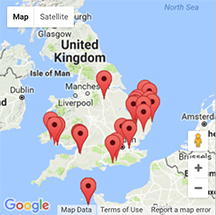The Ancient Human Occupation of Britain (AHOB) was a three-phase project to investigate ancient humans from the Palaeolithic and Mesolithic in northern Europe that ran from 2001 through 2011 with funding from the Leverhulme Trust. This website contains information about the project and provides access to data generated AHOB research.
AHOB Database
THE AHOB database contains information about selected key Pleistocene sites in Britain that document early hominin occupation of northwestern Europe. These data were assembled by researchers working with the project between 2001 and 2015 and are made available here for research, teaching, and other uses.

Click the map to enter the database
AHOB Publications
Here is a random selection from the bibliography of papers published by the AHOB research team.
Humphrey, L. and Stringer, C. 2002. The human cranial remains from Gough's Cave (Somerset, England). Bull.Br.Mus.nat.Hist.(Geol.) 58: 153-168.
[Electronic copy of this text]
For a complete list of AHOB publications, click here. |


